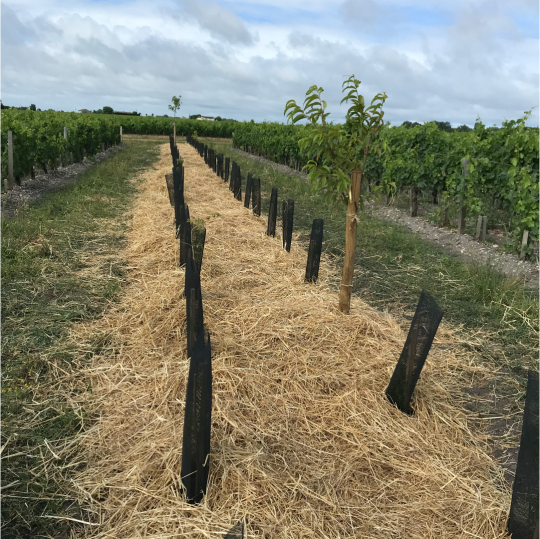Following plot uprooting, certain additional projects can become important, such as adding hedges. Any modification of the plots' surrounding areas is easier to implement after uprooting because it may require new demarcation of the future plot or even a few adjustments (tillage, removal of some end vines or even the removal of an entire row...). Indeed, hedges are often established in a linear way and require spacing. However planting hedges or a grassy strip along the plots edges has many advantages:
1.3.1.c Special arrangements
-
Plots located in high wind or cold current areas can benefit from a windbreak effect through the presence of hedges. To obtain the best windbreak effect, the hedge must be perpendicular to the wind, linear, fairly high, and with shrub development along its entire length. Certain species such as hornbeam, oak or hazel can provide a windbreak effect.
-
The microclimate within the plots can also be modified: the windbreak effect can mean a slight temperature change and either losing or gaining a few degrees depending on the position and proximity of the hedges or trees to the vines.
-
Hedges can act as a barrier to windborne plant protection products.
-
The presence of hedges also helps to fight against erosion, promotes biodiversity through the presence of ecological niches and contributes to the diversification of the landscape. For the positive secondary benefits to be felt, comprehensive knowledge of each host species is necessary as well as an awareness of the potential risks that pests present on these hosts may represent. For example, the hornbeam hedge species can be used to form hedges or trees in the vineyard landscape. It is a host species for typhlodromes, which are greatly appreciated in viticulture as they are predators to mites. The hazelnut tree has a similar impact as it attracts ladybugs.
Agroforestry has many advantages and can be adapted to viticulture, however, certain measures must be respected:
-
Soil preparation
-
The planting period: from autumn to spring, i.e. from November to March, episodes of frost and harsh winters can also hinder the regrowth of planted hedges
-
Maintenance: hedges or trees/shrubs often need to be watered after planting. Winter or summer pruning may also be necessary to control overdevelopment of any vegetation
-
The species chosen must be adapted to the environment as best as possible for the given objectives: this means, for example, using species that are naturally present on the territory and resistant to harsh winters or drought.

